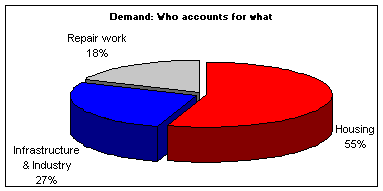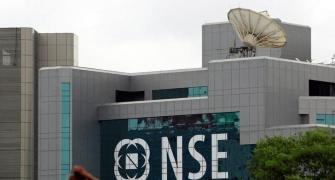Things turned around during the March quarter and helped by a strong increase in both demand as well as prices, profitability improved significantly. During 2004, while the Sensex has witnessed a decline of 2 per cent, the cement index, consisting of the top five cement companies has appreciated by almost 16 per cent.
Taking these results and the appreciation of stock prices into consideration, we feel that based on very realistic demand prospects and a highly probable case for recovery in prices, the much talked about revival might just be around the corner. Let us delve a little deeper into the reasons.
As is seen from the graph below, 55 per cent of the demand for cement comes from the housing sector. This sector has witnessed rapid growth over the past few years. Housing loan disbursals, which can be considered as good indicators of growth in the industry have grown at a CAGR of 30 per cent over the last three years. With a shortfall of 19 mn dwelling units in the country and disbursals expected to grow at a similar rate for at least the next 3 to 4 years, the demand for cement from this sector is likely to grow unabated.

It is no coincidence that China, which has emerged as the fastest growing nation in recent times, is also the largest consumer of cement. While the country accounted for 25 per cent of world GDP growth in recent years, around 40 per cent of the cement consumed in the world is accounted for by China, mainly to create world-class infrastructure and ensure rapid urbanization.
Therefore, if the Indian policy makers have to put the country on a high GDP growth trajectory, sizeable investments in infrastructure will have to be made, thus boosting the demand for cement. With the government going in for 25 per cent concretisation of roads, the construction of highways and rural roads criss-crossing the country is likely to translate into higher demand for cement.
On account of the above-mentioned reasons, we believe that the industry is expected to grow at a healthy rate of 8 per cent-9 per cent over the medium to long term. While the demand has never been a problem for the industry, it is the supply side that has posed some problems. Lower realisations have prevented the industry from prospering.
While the consumer price index has appreciated almost 55 per cent over the last seven years, the cement prices in the country have in fact suffered a fall of around 6 per cent in the same period. Thus, the reason why the industry was going through troubled times becomes evident. High level of fragmentation and increasing demand supply imbalance can be considered as two of the main reasons behind the same.
Simple economics tell us that a large number of players are good for the industry so that no one can exert a control over prices. But it also adds one caveat that for this to happen the markets should be highly efficient. In other words, everyone should have an access to same resources and the laws should strictly be adhered to.
Unfortunately, this is not the case with the Indian cement industry where power thefts and tax evasions pervade the corporate system. As a result, the smaller players, which are not that much in the public eye, are in a position to under cut their bigger counterparts and
Therefore in order to find a solution to such menace, consolidation, where bigger players have a certain degree of control over prices, becomes imperative.
But how is the Indian cement industry placed on this front? Going by the spate of acquisitions by the bigger cement companies in recent times, (Grasim's acquisition of Indian Rayon and L&T's cement business, Gujarat Ambuja's acquisition of DLF Cements and Modi Cement, ACC's acquisition of IDCOL's cement division, Lafarge's acquisition of Tata Steel and Raymond's Cement business etc), we believe consolidation is well and truly underway. Top seven players accounted for nearly 52 per cent of industry capacity in FY00, currently they account for 62 per cent. As is evident from the trends in the developed markets, increased consolidation leads to healthy prices and therefore we believe that with further consolidation in the domestic market, prices are likely to turn remunerative in the coming years.

Apart from low levels of consolidation, frequent capacity additions have also been responsible for sorry state of cement prices in the country. To make things a little clearer, the total capacity additions during FY01 and FY02 amounted to a huge 26 mn tonnes, with 17 m tonnes accretion during FY02 itself. Contrast this with FY97-FY00 period, where a lesser 20 m tonnes of capacity was added, that too in a span of 4 years. Sales tax incentives given by some state government for a limited period were largely responsible for such rampant capacity additions. This led to a scenario where supply grew at a faster pace than demand and caused a downward pressure on the prices.
However, things seem to be improving. No significant greenfield capacity was added during FY03 and FY04. As a result while demand grew, supply almost remained constant and this helped in reducing the demand supply gap and eased off some pressure on the prices. Infact, prices have already improved by around 5 per cent in the March quarter and are expected to rise further in the coming years.
It is being believed that while the northern and eastern regions would achieve demand supply parity by 2005, the southern and the western region would achieve the same by 2007 on account of high demand supply parity prevailing in these regions. Thus an increase in demand coupled with recovery in prices is likely to result into higher profitability for the cement companies.
Thus, while the overall scenario for the growth in the industry looks indeed promising, continued government apathy remains a cause of concern. The excise duty on cement at Rs 400 per tonne is one of the highest in the industry and amounts to roughly around 20 per cent of the ex-factory price of cement. Further, since the industry is freight intensive one, any increase in the prices of petroleum products is likely to put pressure on the margins.
Not withstanding these minor glitches, the industry appears to be well positioned to put the era of depressed prices and reckless capacity additions behind it and grow profitably in the future. However, investors need to look at companies, which have a diversified geographical presence and have a track record of consistently high operating margins.
Equitymaster.com is one of India's premier finance portals. The web site offers a user-friendly portfolio tracker, a weekly buy/sell recommendation service and research reports on India's top companies.







